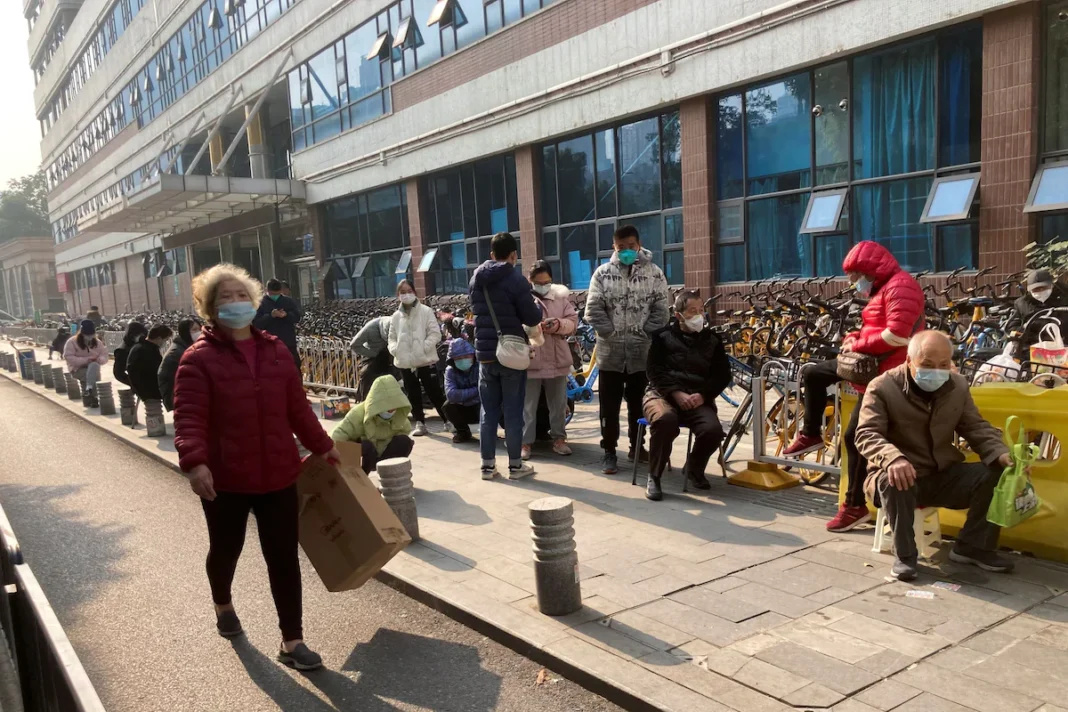Chinese hospitals scrambled to contain emerging outbreaks across the country Monday as authorities rolled back more than two years of coronavirus controls.
After widespread protests against the government’s strict “zero covid” policies, authorities last week announced a dramatic loosening of requirements for testing, digital health passes, and tracking and quarantines. In the days since, hospitals have reported a surge in patients while hundreds of medical staffers have contracted the virus.
Are you on Telegram? Subscribe to our channel for the latest updates on Russia’s war in Ukraine.
Beijing municipal officials said at a briefing Monday that 22,000 patients visited fever clinics the day before, 16 times the daily average a week ago.
China prepares for exit wave of infections as it relaxes covid policies
“Hospitals bore the brunt of zero covid and are now overwhelmed by an unprecedented outbreak,” said Yan, an eye surgeon in Beijing who disclosed only her surname because she was not authorized to speak to media. More than half of the staff members in her hospital had tested positive in the past week.
“Patients who visit the fever clinic have grown several times compared with last week, and it’s likely to go on for weeks or even months more,” she said.
A surge in cases is likely to overwhelm China’s health-care system, which has been focused for the past three years on contact tracing and quarantines rather than building up capacity for coronavirus outbreaks. China has 4.5 intensive care unit beds for every 100,000 people, according to government data, and its latest ambition to double its ICU capacity by the end of December is proving to be harder to achieve than expected.
The National Health Commission on Sunday launched an initiative to ensure that major county-level hospitals are stocked up on medical supplies and ICU equipment. Hospitals have been ordered to expand their staffs by 20 to 30 percent and establish an infectious-disease department by the end of December.
Advertisement
The commission said Friday that it would ensure 90 percent of rural hospitals have fever clinics, while temporary quarantine centers, known as fangcang, will be converted into hospitals.
China logged 8,838 positive tests Sunday, a figure residents said does not reflect the true scope of infections because centralized testing, the only way new infections were identified, has been removed. A contact-tracing app monitoring residents’ movements will cease to function as of Tuesday, and all user data is to be deleted.
Cities pleaded with residents not to call emergency services if their symptoms were not serious, while community and rural clinics complained they were short-staffed, according to local media reports. Panicked residents are stockpiling antigen tests and medication.
A woman collects coronavirus antigen kits from a worker at a pharmacy in Beijing on Sunday. (Andy Wong/AP)
Karen Bai, 36, who lives in Shijiazhuang in Hebei province, has had a fever for three days but has not been able to acquire any at-home tests. Suffering from a blood disease, she is immunocompromised, and her doctor has advised her to stay away from hospitals.
Advertisement
“So many patients have covid but they don’t know it,” she said. “Everyone has been saying life is going to return to normal, but to me it’s gone from bad to worse.”
China’s pursuit of zero covid has resulted in a low level of natural immunity among the public, leaving the population vulnerable. Authorities are especially focused on protecting the elderly, who have lower vaccination rates and are the target of a current vaccination drive. Zhong Wenhong, a Shanghai-based infectious-disease expert, advised elderly residents to refrain from group activities such as dancing in public squares or playing mah-jongg for at least one month.
The Caixin news site reported earlier this month that China aims to vaccinate 90 percent of those ages 80 and above with at least a first shot, but officials have refrained from announcing a specific target given hesitancy among the elderly to get immunized. Just 40 percent of Chinese older than 80 have received a booster shot, despite months of campaigning and gift-giving to encourage uptake.
A worker in protective gear controls the line outside a fever clinic at a hospital in Beijing on Saturday. (Ng Han Guan/AP)
Last week, government adviser Feng Zijian, a former official with the National Health Commission, predicted that 60 percent of the population could be infected in the first wave of infections. Authorities expect an upsurge in cases around Lunar New Year in late January.
China’s coronavirus cases could peak in a month, but it is “more complicated” to predict when the outbreak will end, experts have said.
“In the short run, there will be a massive demand for ICU resources as severe cases rise,” Zhang Ming, the deputy head of the intensive care unit at Zhongshan Hospital in Shanghai, told the financial news outlet Yicai, adding that bigger hospitals in bigger cities tend to be more prepared but that he “cannot speak for the situation in general.”
Amid fear of the virus and after more than two years of official media warnings of its dangers, misinformation has spread, with residents buying up canned peaches after rumors that they would prevent contagion and experts weighing in on whether better-looking people are less likely to contract the virus.
Still, residents say they welcome the opening. “It’s a risk worth taking,” said Yan, the doctor in Beijing. “If the lockdown had gone on, more people would have died from poverty and starvation even if they stayed covid-free.”

